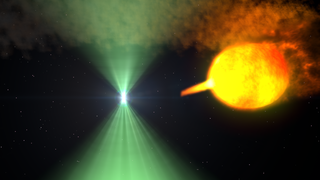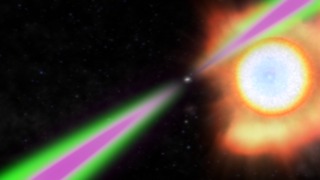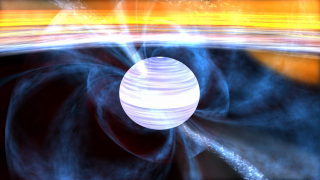Universe
ID: 11609
In late June 2013, an exceptional binary system containing a rapidly spinning neutron star underwent a dramatic change in behavior never before observed. The pulsar's radio beacon vanished, while at the same time the system brightened fivefold in gamma rays, the most powerful form of light, according to measurements by NASA's Fermi Gamma-ray Space Telescope.
The system, known as AY Sextantis, is located about 4,400 light-years away in the constellation Sextans. It pairs a 1.7-millisecond pulsar named PSR J1023+0038 — J1023 for short — with a star containing about one-fifth the mass of the sun. The stars complete an orbit in only 4.8 hours, which places them so close together that the pulsar will gradually evaporate its companion.
To better understand J1023's spin and orbital evolution, the system was routinely monitored in radio. These observations revealed that the pulsar's radio signal had turned off and prompted the search for an associated change in its gamma-ray properties.
What's happening, astronomers say, are the last sputtering throes of the pulsar spin-up process. Researchers regard the system as a unique laboratory for understanding how millisecond pulsars form and for studying details of how accretion takes place on neutron stars.
In J1023, the stars are close enough that a stream of gas flows from the sun-like star toward the pulsar. The pulsar's rapid rotation and intense magnetic field are responsible for both the radio beam and its powerful pulsar wind. When the radio beam is detectable, the pulsar wind holds back the companion's gas stream, preventing it from approaching too closely.
But now and then the stream surges, pushing its way closer to the pulsar and establishing an accretion disk. When gas from the disk falls to an altitude of about 50 miles (80 km), processes involved in creating the radio beam are either shut down or, more likely, obscured. Some of the gas may be accelerated outward at nearly the speed of light, forming dual particle jets firing in opposite directions. Shock waves within and along the periphery of these jets are a likely source of the bright gamma-ray emission detected by Fermi.

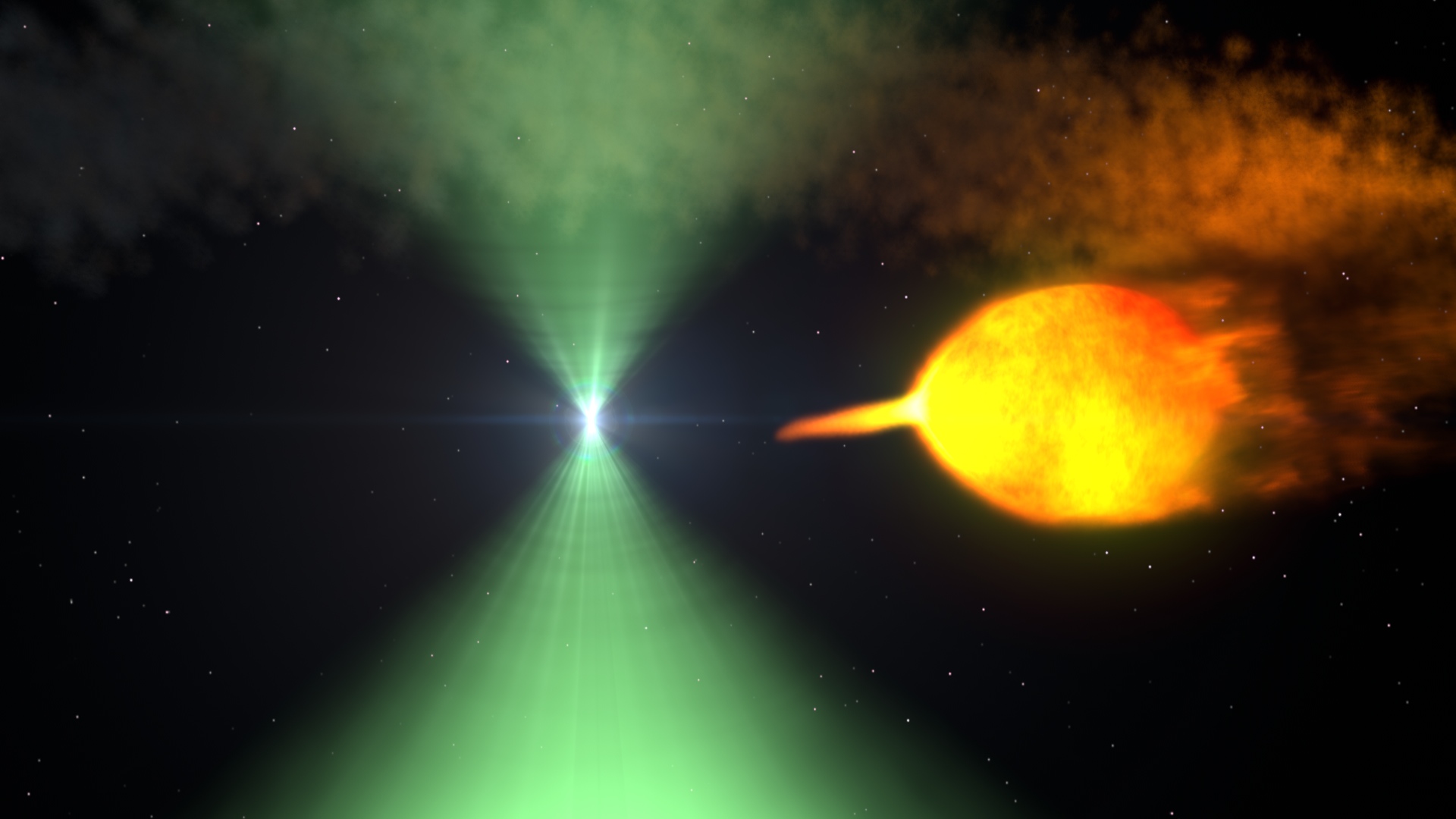
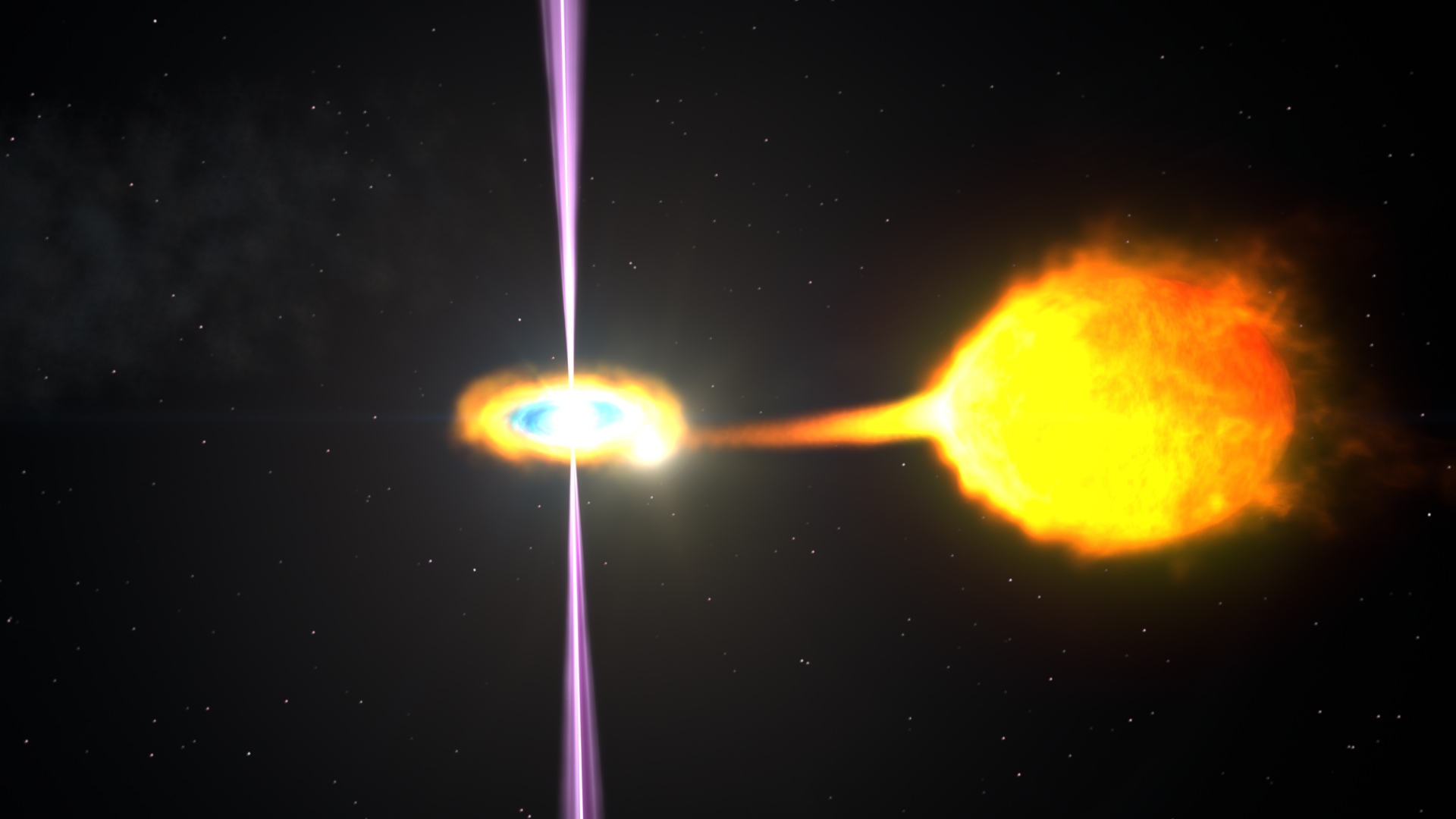
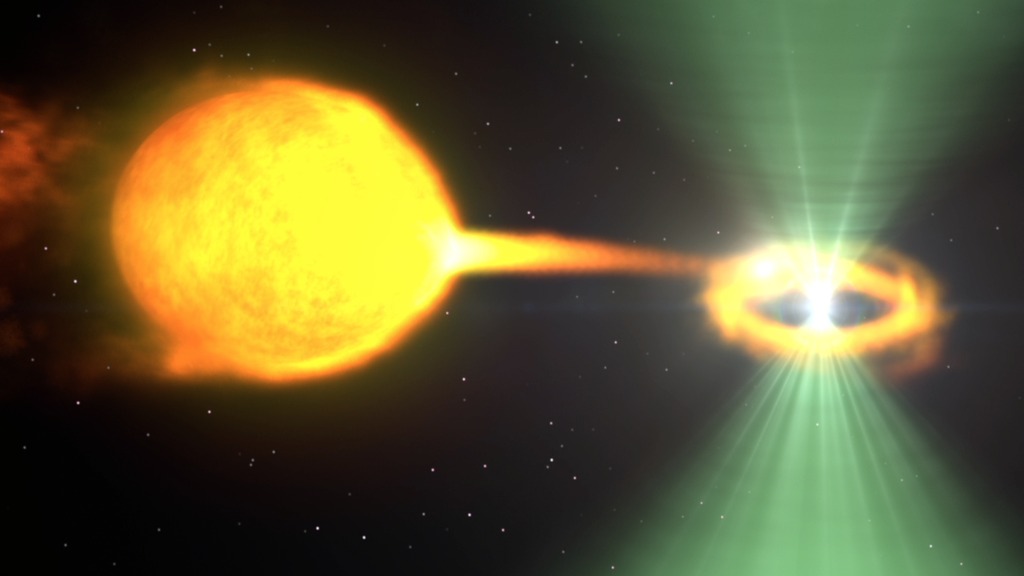
NASA's Fermi Catches a 'Transformer' Pulsar
The system, known as AY Sextantis, is located about 4,400 light-years away in the constellation Sextans. It pairs a 1.7-millisecond pulsar named PSR J1023+0038 — J1023 for short — with a star containing about one-fifth the mass of the sun. The stars complete an orbit in only 4.8 hours, which places them so close together that the pulsar will gradually evaporate its companion.
To better understand J1023's spin and orbital evolution, the system was routinely monitored in radio. These observations revealed that the pulsar's radio signal had turned off and prompted the search for an associated change in its gamma-ray properties.
What's happening, astronomers say, are the last sputtering throes of the pulsar spin-up process. Researchers regard the system as a unique laboratory for understanding how millisecond pulsars form and for studying details of how accretion takes place on neutron stars.
In J1023, the stars are close enough that a stream of gas flows from the sun-like star toward the pulsar. The pulsar's rapid rotation and intense magnetic field are responsible for both the radio beam and its powerful pulsar wind. When the radio beam is detectable, the pulsar wind holds back the companion's gas stream, preventing it from approaching too closely.
But now and then the stream surges, pushing its way closer to the pulsar and establishing an accretion disk. When gas from the disk falls to an altitude of about 50 miles (80 km), processes involved in creating the radio beam are either shut down or, more likely, obscured. Some of the gas may be accelerated outward at nearly the speed of light, forming dual particle jets firing in opposite directions. Shock waves within and along the periphery of these jets are a likely source of the bright gamma-ray emission detected by Fermi.




Related
For More Information
http://www.nasa.gov/content/goddard/nasas-fermi-finds-a-transformer-pulsar/
http://www.nasa.gov/content/goddard/astronomers-uncover-a-transformer-pulsar/
Credits
Cruz deWilde (Avant Gravity): Lead Animator
Scott Wiessinger (USRA): Video Editor
Scott Wiessinger (USRA): Narrator
Scott Wiessinger (USRA): Producer
Anne Archibald (ASTRON): Scientist
Francis Reddy (Syneren Technologies): Writer
Scott Wiessinger (USRA): Video Editor
Scott Wiessinger (USRA): Narrator
Scott Wiessinger (USRA): Producer
Anne Archibald (ASTRON): Scientist
Francis Reddy (Syneren Technologies): Writer
Please give credit for this item to:
NASA's Goddard Space Flight Center. However, individual items should be credited as indicated above.
NASA's Goddard Space Flight Center. However, individual items should be credited as indicated above.
Short URL to share this page:
https://svs.gsfc.nasa.gov/11609
Mission:
Swift
This item is part of these series:
Narrated Movies
Astrophysics Animations
Astrophysics Stills
Astrophysics Features
Goddard TV Tape:
G2014-055 -- Transformer Pulsar
Keywords:
SVS >> HDTV
SVS >> Music
SVS >> Neutron Star
SVS >> X-ray
GCMD >> Earth Science >> Spectral/Engineering >> Gamma Ray
SVS >> Astrophysics
SVS >> Pulsar
SVS >> Edited Feature
SVS >> Space
SVS >> Swift
SVS >> Binary Star
DLESE >> Narrated
SVS >> XMM-Newton observatory
SVS >> Star
NASA Science >> Universe
GCMD keywords can be found on the Internet with the following citation: Olsen, L.M., G. Major, K. Shein, J. Scialdone, S. Ritz, T. Stevens, M. Morahan, A. Aleman, R. Vogel, S. Leicester, H. Weir, M. Meaux, S. Grebas, C.Solomon, M. Holland, T. Northcutt, R. A. Restrepo, R. Bilodeau, 2013. NASA/Global Change Master Directory (GCMD) Earth Science Keywords. Version 8.0.0.0.0
https://svs.gsfc.nasa.gov/11609
Mission:
Swift
This item is part of these series:
Narrated Movies
Astrophysics Animations
Astrophysics Stills
Astrophysics Features
Goddard TV Tape:
G2014-055 -- Transformer Pulsar
Keywords:
SVS >> HDTV
SVS >> Music
SVS >> Neutron Star
SVS >> X-ray
GCMD >> Earth Science >> Spectral/Engineering >> Gamma Ray
SVS >> Astrophysics
SVS >> Pulsar
SVS >> Edited Feature
SVS >> Space
SVS >> Swift
SVS >> Binary Star
DLESE >> Narrated
SVS >> XMM-Newton observatory
SVS >> Star
NASA Science >> Universe
GCMD keywords can be found on the Internet with the following citation: Olsen, L.M., G. Major, K. Shein, J. Scialdone, S. Ritz, T. Stevens, M. Morahan, A. Aleman, R. Vogel, S. Leicester, H. Weir, M. Meaux, S. Grebas, C.Solomon, M. Holland, T. Northcutt, R. A. Restrepo, R. Bilodeau, 2013. NASA/Global Change Master Directory (GCMD) Earth Science Keywords. Version 8.0.0.0.0
